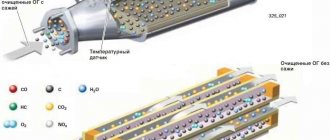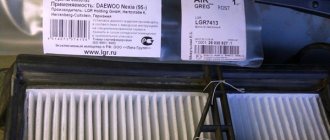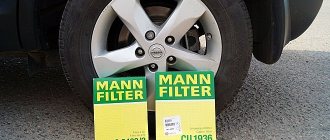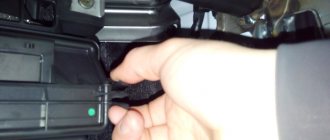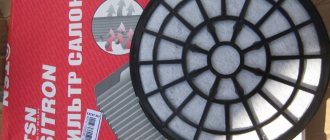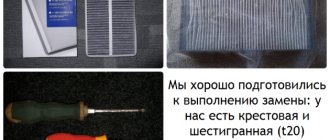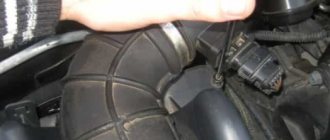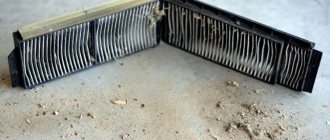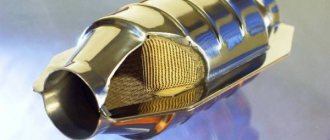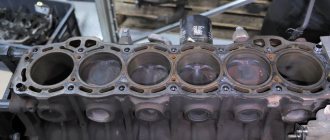At the end of the last century, environmentalists began to vigorously fight the owners of automobile companies and oil rigs, accusing them of excessive environmental pollution. In order to somehow calm down the indignation of the fighters for a clean atmosphere, the designers developed such a part as a particulate filter. With the beginning of its use in the automotive industry, we stopped breathing soot, which is released during the combustion of diesel fuel in the engine.
Why is it used?
At this point in time, manufacturers are struggling to improve the level of environmental safety of cars. The consequence of this was the mandatory installation of particulate filters on cars equipped with diesel engines. This is a mandatory condition for trucks since the introduction of the EURO 4
, and since 2009, after the introduction of the
EURO 5
. The rule also applies to all vehicles with diesel engines.
This reduces the level of soot emissions into the atmosphere, which are inevitably formed during the combustion of diesel fuel. But, the consequence of this was some complication of the design. Still, additional components in the exhaust system affect the power and efficiency of the engine.
Technical features
There are several types of such filters. All of them are used in modern vehicles, so it makes sense to understand their features in more detail. The main differences between different types of similar filters are the cleaning features. Here are the types that can be found on passenger cars:
- DPF
is a closed filter. The passive regeneration method is used for cleaning. They are impossible to clean. Typically used on Volkswagen vehicles, as well as by some of their partners; - FAP
stands for closed filter with forced regeneration. Developed by the Peugeot-Citroen concern. As a rule, when the filter is clogged with soot, the engine control unit gives a command to inject an additive, which causes the filter to be cleaned. In general, the service life of such a device is longer. Widely used on cars of Ford, Toyota and some others.
Active regeneration
This mode allows you to perform cleaning by automatically turning on the engine control controller. First, it analyzes the received data from temperature and pressure sensors, then it signals that the filter element is clogged with soot particles, then the temperature sensor measures its value. If its level is insufficient to burn soot, then the controller injects additional fuel when exhaust gases are released, this leads to fuel combustion immediately in the exhaust system and raises the temperature of the gases to the required level.
If the exhaust system installed on a diesel engine contains other measures in its arsenal aimed at increasing the temperature level of exhaust gases, then the control controller also puts them into action.
Flushing
This method involves cleaning the particulate filter using special compounds injected or poured inside. The reagents make the soot soft and remove it from clogged pores, after which it is burned when the car moves.
Symptoms of a problem
First, let's figure out when to replace this filter, or rather, let's look at the signs of a malfunction. This will allow you to respond to the problem in a timely manner. In fact, the problem is defined quite simply:
- First of all, we look at the dashboard. If there is a problem with the filter, the engine fault warning light will come on. If you conduct a diagnostic scan, an error will be displayed in the sensor that controls the operation of the particulate filter. With further operation of the vehicle, the control unit will limit the functionality of the motor;
- When the engine operates in different modes, malfunctions may occur;
- Significant reduction in dynamics
. The car begins to noticeably slow down; - The lubricant level in the engine may increase.
All of the above will let you know that it is time to replace the particulate filter. Moreover, to preserve the performance of the car, it is better to do this as quickly as possible.
Change or throw away?
It is worth noting that the particulate filter is quite expensive. Depending on your car model, the purchase can cost from $200 to $2500
. This is quite a lot of money, which is spent on consumables.
Therefore, drivers are beginning to think about whether it is worth buying and installing a new filter, or whether it can be completely removed. In fact, there are many features that are worth considering. This is the need to solve the problem of adding a missing exhaust pipe segment (on some models). You will also need to solve the problem of disconnecting the sensor. After all, if you simply turn it off, the car simply won’t start. Let's look at the nuances in more detail.
Pros and cons of deletion
To begin with, let’s carefully analyze the positive features that await you in the event of such a modification:
- You are guaranteed to eliminate the possibility of this problem occurring in the future;
- Average fuel consumption will decrease slightly;
- The dynamic characteristics of the car will be completely restored, you will definitely like it;
- For engines with particulate filters, specialized oils are recommended, which are quite expensive. Removing this part will allow the engine to be filled with regular synthetic oil;
- You will not need to periodically refill the filter with expensive reagents;
- The cost of removing a part is significantly lower than purchasing a new part. Even if you do not do this work yourself.
As you can see, there are quite a lot of positive features from this modification. But there are also a number of difficulties that result from removing the filter.
Minuses.
There are plenty of disadvantages to such a conversion. For some people, the restrictions that have appeared make such modifications completely meaningless. Therefore, you need to know what such repairs can entail. The disadvantages are the following:
- The car will not be allowed into Europe. After removing the particulate filter, the car will not pass exhaust gas control at customs. If you travel often or are planning a trip to Europe, you should not remove this part;
- If the car is under warranty
, you will lose it; - When the engine is running at high speeds, you may notice that the smoke from the exhaust pipe will be much darker than it should be;
- The turbine may whistle;
- The catalyst is also removed. Therefore, the car may not be able to pass technical inspection;
- As a result of malfunctions in the engine control unit, negative consequences may occur in the form of damage to the exhaust system.
Cleaning the particulate filter
KUZOV magazine, together with LIQUI MOLY, tested a new product for cleaning and protecting particulate filters.
With modern diesel cars equipped with additional exhaust gas after-treatment devices (DPF particulate filters), problems have arisen in their operation. The smaller the difference in exhaust gas pressure at the inlet and outlet of the particulate filter, the more efficiently the engine operates, the more economical fuel consumption is and the minimal pollution of the environment.
However, during the entire period of operation, solid soot particles, which are unburned particles of hydrocarbons, enter the pores of the particulate filter walls, limiting the flow of exhaust gases. The fine soot powder seems to be supposed to burn, but as the filter clogs, it mixes more and more with non-combustible materials and forms resins. This sticky mixture, coupled with metal sulfates, which are formed during the combustion of low-quality motor oil, clogs the particulate filter, creating increased back pressure of the exhaust gases inside.
The particulate filter can become almost completely clogged after just a few hundred kilometers, so the developers have provided a clever system for its “regeneration” - a process that oxidizes the resins inside the filter, after which they burn out. When the gas pressure at the DPF inlet and outlet exceeds the permissible limit, the engine control unit turns on the burnout mode.
The computer enriches the fuel mixture, causing the exhaust gas temperature to rise sharply. The load on the catalyst increases, and it, in turn, heats up to several hundred degrees, oxidizing the vapors of unburned fuel. After this, a hot mixture enters the particulate filter, which burns out deposits and cleans the filter. The same process can be initiated chemically - by adding a special additive that activates burn-through. At one time, the Volkswagen concern used this technology, and today designers from Peugeot and Citroen are passionate about similar developments.
For cars of various brands, the burnout mode is activated under quite standard conditions. To do this, the car must be in motion and the engine must be running at medium or high speed. In dense city traffic, it is not always possible to achieve suitable conditions, so the filter continues to retain soot without self-cleaning, which leads to its complete clogging.
Ideally, the service life of a particulate filter is 150,000–200,000 kilometers, and self-regeneration occurs only once every 500–700 kilometers. However, in city traffic this part becomes unusable much earlier. Prolonged driving in traffic jams, poor quality fuel, elevated ambient temperatures and aggressive driving style lead to the process of burning through the filter starting every 50–100 kilometers, which shortens the life of the unit to 50,000–60,000 kilometers. This is explained by the fact that during each regeneration, part of the platinum from the catalyst burns out along with petroleum products, which significantly affects its residual life.
In addition, in order to effectively burn out all the resins from the cavities, it is necessary to heat the catalyst to 600–650 °C, which is almost impossible to do during a trip. As soot accumulates inside the system, the difference in gas pressure at the inlet to the filter and at the outlet from it will one day exceed the permissible values. As a result, when the particulate filter is more than 90% dirty, the engine will simply lose power and stall.
If a corresponding signal about a problem appears on the car’s dashboard, you must immediately contact a service station. An experienced diagnostician will check the system and issue a conclusion. Often, manufacturers do not regulate the repair of dirty particulate filters, offering only a complete replacement of the part. Thus, by systematically pouring low-quality Russian diesel fuel into his car, the car owner obviously “signs up” for constant and expensive repairs. The cost of particulate filters themselves from top brands alone exceeds 100,000 rubles.
Of course, the car owner cannot influence the quality of the fuel, but he can take care of the safety of the filter. To achieve this, LIQUI MOLY has developed a program for the protection and cleaning of particulate filters, which includes two fundamentally different cleaning technologies and a special additive to facilitate filter regeneration.
The first technology allows you to work literally “on your knees” and not use scarce and expensive diagnostic devices. However, it is labor-intensive, requires a lot of time and involves removing the particulate filter. The second technology is faster, but requires the use of complex electronic equipment. As for the results, that is, the effectiveness of the product compositions, they are identical. According to LIQUI MOLY specialists, the cost of this service will not exceed 10,000–15,000 rubles, which is significantly cheaper than a complete filter replacement.
The editors of the KUZOV magazine decided to independently test the new system and demonstrate its operation to readers. To do this, the publication's correspondents chose an independent service station specializing in Mercedes-Benz cars, where Dmitry Rudakov, a specialist from LIQUI MOLY , was asked to show and prove the effectiveness of the system on a third-generation Mercedes ML model.
The difficulty of working with Mercedes models is determined both by the inaccessibility of the particulate filter itself and by diagnostic features. For example, when checking Volkswagen cars, the filter status is displayed as a percentage on the diagnostic scanner screen, which greatly simplifies the decision-making process. Mercedes, on the contrary, only indicates a malfunction, indicating discrepancies in ideal and real values. Thus, the master must himself determine the nature of the upcoming repair.
To carry out the work, specialist Dmitry Rudakov will first of all need the LIQUI MOLY Pro-Line Diesel Partikel filter Reiniger cleaner and the Pro-Line Diesel Partikel filter Spulung wash/neutralizer.
The cleaning solution must be poured into a special tank onto which a gun with one of the attached probes is attached. Straight and curved manipulators allow you to work with almost all manufactured vehicles.
It is necessary to make sure that the temperature of the particulate filter is about 40 ° C, since it is under such conditions that the effect is most effective. The temperature can be seen on the screen of diagnostic equipment, but if it is not at hand, it is enough to measure the heating of the filter with an optical household pyrometer.
Next, you can remove the oxygen sensor located in front of the particulate filter, through which cleaning liquid will be supplied in portions. However, in our case, the specialist did not do this, since it is convenient to use a different hole on Mercedes. A LIQUI MOLY representative removed the catalyst temperature sensor, which is located in the middle of the filter, between the catalyst and the active DPF element. Access of cleaning fluid through this opening ensures proper distribution of the fluid in all cavities.
After test spraying, the cleaning composition is fed through the above opening into the filter in several stages. During this process, the probe must be rotated slowly, thereby ensuring uniform distribution of the product.
Now you need to wait 15 minutes and pour the remover/neutralizer inside in the same way. After finishing cleaning, replace the temperature sensor.
To evaporate the remaining composition from the filter, you need to start the engine and warm up the filter to an operating temperature of 300°C. After this, using a diagnostic scanner, you need to start the forced regeneration mode. Next, you should drive 10 kilometers by car for 10–20 minutes.
If it is not possible to leave the service station, you will have to simply press the gas pedal for the same time interval, but this must be done either on the street or with the exhaust gas removal system connected. After just a couple of minutes of running the engine under load, thick white smoke will pour out of the exhaust pipe. This indicates that the procedure was carried out correctly.
A diagnostic scanner will also help determine how well the filter is cleaned. To do this, it is enough to check the readings of the exhaust gas pressure sensors at the inlet and outlet of the particulate filter as a percentage before and after the procedure. The effectiveness of the solution can also be judged by temperature values.
In our case, a reliability check showed that the catalyst temperature of 190°C is almost equal to the temperature inside the particulate filter - 180°C. According to standards, these readings should not differ by more than 60°C.
According to LIQUI MOLY estimates, the cost of the procedure for cleaning the particulate filter can vary between 10,000–15,000 rubles. This amount includes wages, consumables and self-sufficiency of equipment, the price of which is 15,000 rubles. However, this is significantly cheaper than completely dismantling a damaged particulate filter, purchasing a new filter and then installing it.
According to Dmitry, on business-class cars it is advisable to carry out the procedure for cleaning the particulate filter together with changing the oil and cleaning the injector; it is advisable to include it in the list of routine maintenance every 10,000–20,000 kilometers. On budget cars, this should be done only as needed when a corresponding error appears.
As we have already said, the service life of a particulate filter is determined by the frequency of its burn-through. The more often this procedure occurs, the more catalyst (platinum) burns out irrevocably. Today it has become possible to increase the mileage between burns and reduce the process temperature. For this purpose, LIQUI MOLY has developed an additive to protect the diesel particulate filter Diesel Partikel filter Schutz, which we will discuss in detail in a separate article.
Article from the magazine "Body"
conclusions
The particulate filter is an important part of a car's exhaust system. Therefore, when deciding to remove it, you should carefully weigh all the pros and cons of this action. At the same time, it is worth noting that the positive consequences do not quite balance out the disadvantages, and you need to look at it taking into account your requirements for the vehicle.
You need to understand that the work of removing the filter also costs money. Therefore, you need to take into account all the features and consequences of removing a diesel particulate filter, and only after that make a decision about dismantling.
Methods for cleaning the particle filter
DPF cleaning can be done at any service station. But this procedure is not cheap, so you can clean the diesel particulate filter yourself. There are several ways to do this.
Use of additives
Some brands of cars have additional additive reservoirs next to the main fuel tank.
The latter include special substances that accelerate the deposition of soot in the filter. Additives are added to the fuel under electronic control. Most additives are based on zinc oxide. It is capable of binding the smallest soot particles into a dense layer that settles in the cells of the filter element. When the layer is formed, it is saturated with oxygen. This significantly increases the efficiency of afterburning.
Even if a diesel car does not have a special tank for additives, the car owner can add them directly to the gas tank. However, the effectiveness of such cleaning is questionable. The fact is that long-term use of additives leads to the appearance of plaque on the walls of the channels that remove exhaust gases. Over time, sediment can completely clog them. Because of this, the catalyst has to be changed not at 120,000 km, but after only 80,000 km or even less. The negative effects of additives can be avoided by flushing the channels.
Flushing the diesel particulate filter
Experienced car enthusiasts wash the particulate filter in their cars using conventional spray bottles equipped with a long and thin tube. The procedure takes place in several stages:
- You need to warm up the engine and then let it cool to a temperature of 40°. A difference of a few degrees doesn't matter. Then you should unscrew the exhaust gas pressure sensor and insert a thin spray tube in its place. The latter should first be filled with a rinsing solution. After this, 200 ml of liquid is pumped into the block using a spray bottle. After 15 minutes, another 200 ml is added. The procedure should be repeated until the total volume of liquid poured reaches 1 liter. While filling the block, the spray tube must be rotated so that the flushing mixture reaches all filter cells.
- The first step is to always use a flammable liquid to clean the filter. To prevent it from flaring up, it must be washed out of the exhaust system. For this, a neutralizing solution is used. It must be administered in exactly the same way, only in a smaller volume - 0.5 liters. After half an hour, the pressure sensor is installed in its place, the engine starts and warms up. Warming up is necessary to evaporate residual fluid from the exhaust system.
You can also wash the particulate filter yourself without using a spray bottle. To do this, you need to buy a special product in a can in the store. The capacity of the latter usually does not exceed 400 ml. This volume of foam cleaner is usually enough to completely clean the filter element. Since the cleaner is foamy, the filtration unit should be refilled with it in small portions with a temporary break between them.

